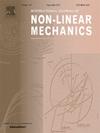Unified model for shear strength of soft and hard rock masses based on in-Situ direct shear test parameters
IF 3.2
3区 工程技术
Q2 MECHANICS
International Journal of Non-Linear Mechanics
Pub Date : 2025-09-06
DOI:10.1016/j.ijnonlinmec.2025.105233
引用次数: 0
Abstract
The nonlinear evolution of rock mass shear strength and its coupling with structural plane morphology represent a critical scientific challenge in geotechnical stability analysis. Existing shear strength models based on in-situ direct shear tests lack universality for both soft and hard rock masses, failing to meet rapid stability assessment needs in engineering practice. To address this gap, the study improves the Mohr-Coulomb criterion by incorporating a normal stress modulation coefficient (κ) and a shear plane undulation coupling coefficient (λ). A unified shear strength model for soft-hard rock masses, accounting for normal stress effects, is proposed. The model's validity is confirmed using in-situ direct shear test data from engineering sites. The results demonstrate excellent fitting of experimental data. Hard rocks exhibit characteristics of normal stress suppression coupled with undulation enhancement, while soft rocks display normal stress strengthening and undulation weakening. Structural plane specimens exhibit normal stress inhibition resulting from plastic deformation, while residual interlocking maintains positive contributions from undulations. The model reveals the differential governing mechanisms of normal stress and shear plane undulation on shear strength in soft-hard interbedded rock masses, providing a theoretical foundation for rapid stability assessments in rock mass engineering.
基于原位直剪试验参数的软、硬岩体抗剪强度统一模型
岩体抗剪强度的非线性演化及其与结构面形态的耦合是岩土稳定性分析的重要科学挑战。现有的基于原位直剪试验的抗剪强度模型对软、硬岩体都缺乏通用性,不能满足工程实践中快速稳定性评价的需要。为了解决这一差距,该研究通过纳入法向应力调制系数(κ)和剪切面波动耦合系数(λ)来改进Mohr-Coulomb准则。提出了考虑正应力效应的软硬岩体统一抗剪强度模型。利用工程现场直剪试验数据,验证了模型的有效性。结果表明,该方法与实验数据拟合良好。硬岩表现为正应力抑制和波动增强的特征,软岩表现为正应力增强和波动减弱的特征。结构面试样表现出由塑性变形引起的正常应力抑制,而残余联锁保持波动的积极贡献。该模型揭示了软-硬互层岩体中正应力和剪切面波动对抗剪强度的差异调控机制,为岩体工程中快速稳定性评价提供了理论基础。
本文章由计算机程序翻译,如有差异,请以英文原文为准。
求助全文
约1分钟内获得全文
求助全文
来源期刊
CiteScore
5.50
自引率
9.40%
发文量
192
审稿时长
67 days
期刊介绍:
The International Journal of Non-Linear Mechanics provides a specific medium for dissemination of high-quality research results in the various areas of theoretical, applied, and experimental mechanics of solids, fluids, structures, and systems where the phenomena are inherently non-linear.
The journal brings together original results in non-linear problems in elasticity, plasticity, dynamics, vibrations, wave-propagation, rheology, fluid-structure interaction systems, stability, biomechanics, micro- and nano-structures, materials, metamaterials, and in other diverse areas.
Papers may be analytical, computational or experimental in nature. Treatments of non-linear differential equations wherein solutions and properties of solutions are emphasized but physical aspects are not adequately relevant, will not be considered for possible publication. Both deterministic and stochastic approaches are fostered. Contributions pertaining to both established and emerging fields are encouraged.

 求助内容:
求助内容: 应助结果提醒方式:
应助结果提醒方式:


